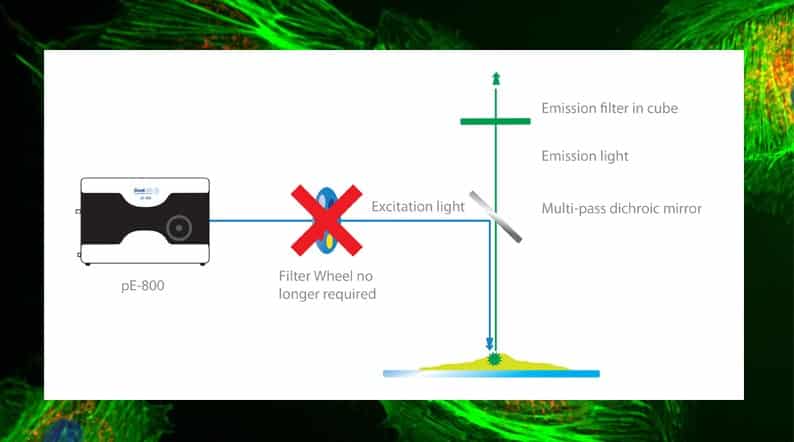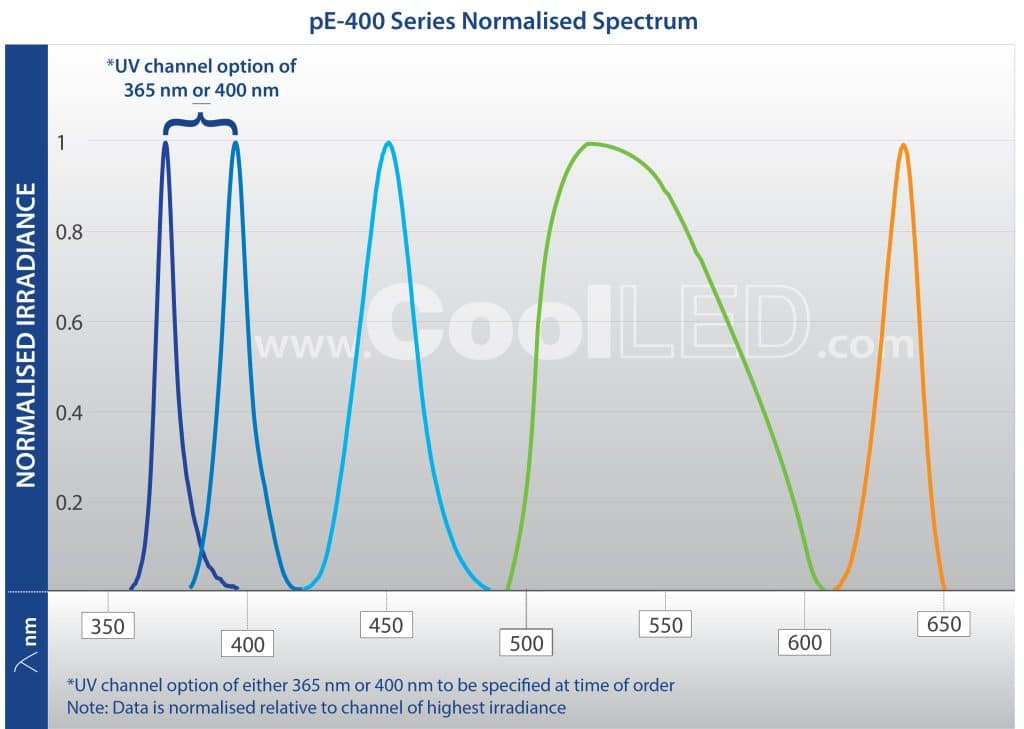Working smarter with LEDs and optical filters for widefield fluorescence
Sponsored by CoolLED, on 13 September 2023
Optical filters can make or break a fluorescence microscopy experiment. For widefield fluorescence, they also have the potential to unlock breakthroughs in high-speed, high-contrast imaging when used alongside multi-channel LED illumination systems.
There are thousands of filters and dichroic mirrors to choose from, with the selection depending on the fluorophore(s) and light source. While imaging a single fluorophore is relatively simple, capturing multiple fluorophores in a single experiment requires extra consideration to balance speed, contrast and budget – and it might be worth considering filter configurations beyond single-band or multi-band sets.
Pinkel filters – This configuration uses single-band excitation filters with a multi-band dichroic mirror and multi-band emission filter. By taking advantage of individual channel switching of LED Illumination Systems such as the CoolLED pE-800 Series, where the single-band filters are instead housed in the Illumination System, in front of each LED, sequential imaging is possible at speeds under <7 µs (Figure 1). However, the multi-band emission filter can still risk some bleed-through and a reduction in contrast in some experiments due to the broad spectral nature of fluorophore emissions.

Sedat filters – To avoid any risk of bleed-through, a Sedat filter configuration uses a similar setup to the Pinkel, but also with single-band emission filters. To avoid the use of emission filter wheels (where movement can introduce latency and restrict imaging speeds), a clever trick is to incorporate an image splitter into the emission light path. These split the emission light path into up to four images displayed on different areas of the camera chip (or different camera in the case of a camera splitter), and house the single-band emission filters which sit in the light path. This setup combines the high contrast of a Sedat filter set with <7 µs LED switching speeds.
Top Tips
To achieve the best results when using LED microscopy illumination, also consider the following points:
LED spectra are wider than lasers: LEDs have broader spectra than lasers, and unlike lasers can be tailored using optical filters to excite a broader range of fluorophores. For example, the blue LED of the CoolLED pE-400 Series (Figure 2) can excite CFP, GFP or Ch2 if used with the appropriate excitation filters. The green-yellow-red (GYR) LED is even broader. When considering if an LED will excite your fluorophore of interest, it is crucial to view the LED spectrum instead of the peak wavelength alone.

LEDs require excitation filters: LED spectra are not just wider than lasers, but often have ‘tails’ which can contribute to background noise. LEDs always require excitation filters to block unwanted wavelengths, even when exciting a fluorophore using only the corresponding LED…
Utilise individual LEDs to enhance contrast: No optical filter provides a complete block to unwanted light. White light illumination will therefore result in higher background when compared to utilising a single corresponding LED, for example from a multi-channel LED illumination system featuring individual channel control.
Upgrading your light source? Check your filters: Filters were historically designed around the irradiance peaks of mercury and metal halide lamps. When used with LED illumination systems, the poor matching of excitation filters reduces excitation light irradiance and therefore signal, which can compromise image quality and impact data interpretation. Upgrading a light source requires a rethink of optical filters, and a shift towards LED-compatible filters matching the spectra of LEDs and popular fluorophores.
Take a shortcut: Choosing the optimal individual filter sets can seem daunting, but online resources can help. To visualise the spectral profiles of filters, fluorophores, and light sources together, FPbase is a great place to start. Alternatively, filter manufacturers offer their own tools (see Chroma Spectra Viewer and Semrock SearchLight). If you have a CoolLED Illumination System, we’ve done the hard work for you, and you can use the CoolLED Filter Finder Tool to identify Chroma and Semrock filters optimised for your Illumination System and fluorophores.
If you have specific optical filter requirements: There are often too many filters for manufacturers to list on their websites, but they are likely to have a filter set to suit your individual requirements if you ask.
Summary
As many labs and facilities are switching over to LEDs from traditional mercury or metal halide lamps, the careful selection of optical filters plays a pivotal role in the success of this transition.
Furthermore, embracing the unique characteristics of solid-state LEDs, such as their high-speed switching times and discrete spectra, can enhance experimental outcomes and facilitate scientific breakthroughs using a standard widefield fluorescence setup.
Please contact info@coolled.com if you have any questions or require support with selecting optical filters.
About CoolLED
CoolLED designs and manufactures cutting edge LED Illumination Systems using the latest LED technology. Since our team of four introduced the first commercially available LED Illumination System in 2006, we have led the way in transforming LED microscope lighting for fluorescence microscopy and transmitted illumination. Now we are a fast-growing company in Hampshire, UK, with a vast product range and technical expertise spanning optical engineering and the life sciences.



 (No Ratings Yet)
(No Ratings Yet)